Novel Microsatellite Tags Hold Promise for Illuminating the Lost Years in Four Sea Turtle Species
Abstract
:Simple Summary
Abstract
1. Introduction
2. Materials and Methods
2.1. Overview of the Study
2.2. Capture and Husbandry
2.2.1. Florida
2.2.2. The Cayman Islands
2.2.3. Azores
2.2.4. Jekyll Island
2.3. Turtles’ Sizes and Growth Curves
2.4. Tag Specifications
2.5. Optimization of Transmission Schedules
2.6. Attachment Methods
2.7. Release Methods
2.7.1. Florida
2.7.2. The Cayman Islands
2.7.3. Azores
2.7.4. Jekyll Island
2.8. Tag Performance Metrics
2.8.1. Transmission Features
2.8.2. Transmission Performances
2.9. Tag Failure Investigations
2.9.1. Software Issues
2.9.2. Battery Exhaustion
2.9.3. Tag Damages and Stranding
2.9.4. Biofouling (Saltwater Switch Fail)
2.9.5. Tag Detachment Due to Turtle Growth
2.10. Statistical Analyses
2.10.1. Statistical Comparison
2.10.2. Tracking Duration Analysis
- If β < 1, the failure rate is decreasing, typical of the “burn-in” period. This kind of failure rate indicates an “early failure” and is typically associated with systems with manufacturing defects;
- If β = 1, the failure rate is constant, typical of the “useful life” period. This failure rate indicates a uniform failure probability in time and is typically associated with “random failures”;
- If β > 1, the failure rate, is increasing, typical of the “wear-out” period. It clearly indicates that the failure probability increases with time and is typically associated with “fatigue failures”.
3. Results
3.1. Transmission Features
3.2. Transmission Performances
3.2.1. Location Error Radius
3.2.2. Transmission Regularity Ratio
3.3. Tag Lifetime
3.3.1. Tracking Duration
3.3.2. Identification of Failure Causes
3.4. Diving Data
4. Discussion
4.1. Good Transmissions despite Unfavorable Features Due to Miniaturization
4.2. Abnormally Short Tracking Durations, Which Do Not Allow for Correct Trajectory Analyses
5. Conclusions
Author Contributions
Funding
Institutional Review Board Statement
Informed Consent Statement
Data Availability Statement
Acknowledgments
Conflicts of Interest
Appendix A
| Release Date | Tag ID | Tag Type | Attachment Method | Species | Straight Carapace Length [cm] | Weight [g] |
|---|---|---|---|---|---|---|
| 31 August 2020 | 202984 | NS | DC1 | DC | 8.69 | 112 |
| 202985 | NS | DC1 | DC | 9.04 | 122 | |
| 202986 | NS | DC1 | DC | 8.70 | 109 | |
| 202987 | NS | DC1 | DC | 9.13 | 116 | |
| 202988 | NS | DC1 | DC | 9.36 | 130 | |
| 202989 | NS | DC1 | DC | 8.69 | 108 | |
| 202990 | NS | DC1 | DC | 9.03 | 116 | |
| 202991 | NS | DC1 | DC | 8.60 | 111 | |
| 202993 | NS | DC1 | DC | 9.27 | 117 | |
| 18 September 2020 | 202981 | NS | DC1 | DC | 9.07 | 105 |
| 202982 | NS | DC1 | DC | 8.85 | 114 | |
| 202992 | NS | DC1 | DC | 8.75 | 108 | |
| 203078 | NS | DC1 | DC | 8.38 | 99 | |
| 203079 | NS | DC1 | DC | 9.41 | 123 | |
| 203080 | NS | DC1 | DC | 8.73 | 108 | |
| 203081 | NS | DC1 | DC | 9.15 | 117 | |
| 203436 | NS | DC1 | DC | 9.11 | 107 | |
| 203437 | NS | DC1 | DC | 9.04 | 112 | |
| 3 August 2021 | 214066 | NS | DC2 | DC | 8.82 | 123 |
| 214067 | NS | DC2 | DC | 9.09 | 126 | |
| 214068 | NS | DC2 | DC | 8.98 | 130 | |
| 214070 | NS | DC2 | DC | 8.78 | 126 | |
| 214071 | NS | DC2 | DC | 8.03 | 109 | |
| 214073 | NS | DC2 | DC | 9.62 | 155 | |
| 214074 | NS | DC2 | DC | 9.01 | 133 | |
| 214075 | NS | DC2 | DC | 8.45 | 107 | |
| 214076 | NS | DC2 | DC | 9.11 | 131 | |
| 214078 | NS | DC2 | DC | 8.90 | 127 | |
| 214079 | NS | DC2 | DC | 9.27 | 132 | |
| 214080 | NS | DC2 | DC | 8.74 | 128 | |
| 23 August 2021 | 202981 | NS | DC2 | DC | 9.65 | 138 |
| 202982 | NS | DC2 | DC | 8.57 | 127 | |
| 202983 | NS | DC2 | DC | 8.90 | 117 | |
| 202984 | NS | DC2 | DC | 9.02 | 145 | |
| 202986 | NS | BD | Drifter | - | - | |
| 202987 | NS | BD | Drifter | - | - | |
| 202988 | NS | DC2 | DC | 8.67 | 133 | |
| 202989 | NS | DC2 | DC | 9.41 | 136 | |
| 202990 | NS | DC2 | DC | 9.58 | 132 | |
| 202991 | NS | DC2 | DC | 8.85 | 118 | |
| 202992 | NS | BD | Drifter | - | - | |
| 214072 | NS | DC2 | DC | 9.04 | 150 | |
| 22 September 2021 | 203437 | NS | DC2 | DC | 8.82 | 117 |
| 212838 | NS | MD | Drifter | - | - | |
| 212839 | NS | DC2 | DC | 9.21 | 117 | |
| 212840 | NS | DC2 | DC | 9.28 | 129 | |
| 10 August 2022 | 236284 | NS | DC3 | DC | 8.52 | 117 |
| 236285 | NS | DC3 | DC | 8.56 | 99 | |
| 236286 | NS | DC3 | DC | 8.07 | 93 | |
| 236287 | NS | DC3 | DC | 8.96 | 120 | |
| 236293 | S | DC3 | DC | 7.14 | 70 | |
| 236294 | S | DC3 | DC | 7.32 | 68 | |
| 236295 | S | DC3 | DC | 7.26 | 70 | |
| 236299 | S | DC3 | DC | 8.43 | 108 | |
| 236302 | SD | DC3 | DC | 7.47 | 75 | |
| 236305 | SD | DC3 | DC | 8.90 | 126 | |
| 236310 | SD | DC3 | DC | 7.42 | 79 | |
| 22 September 2022 | 212848 | NS | CC/LK | CC | 11.61 | 265 |
| 212849 | NS | CC/LK | CC | 11.35 | 268 | |
| 236288 | NS | CC/LK | CC | 11.80 | 268 | |
| 236289 | NS | CC/LK | CC | 11.36 | 249 | |
| 236292 | NS | CC/LK | CC | 11.45 | 274 | |
| 236296 | S | CC/LK | CC | 9.58 | 156 | |
| 236297 | S | CC/LK | CC | 9.43 | 143 | |
| 236298 | S | CC/LK | CC | 9.84 | 185 | |
| 236301 | S | CC/LK | CC | 9.45 | 143 | |
| 236303 | SD | DC3 | DC | 9.47 | 138 | |
| 236306 | SD | CC/LK | CC | 9.44 | 137 | |
| 236308 | SD | CC/LK | CC | 10.08 | 192 | |
| 236309 | SD | CC/LK | CC | 9.14 | 136 | |
| 29 October 2022 | 212844 | NS | CC/LK | CC | 19.30 | 1069 |
| 15 November 2022 | 235356 | S | CM5200 | CM | 9.82 | 146 |
| 236290 | NS | CM5200 | CM | 10.81 | 168 | |
| 236291 | NS | CM5200 | CM | 10.08 | 167 | |
| 236300 | S | CM5200 | CM | 10.18 | 150 | |
| 236304 | SD | CM5200 | CM | 10.40 | 161 | |
| 236307 | SD | CM5200 | CM | 10.23 | 157 |
| Release Date | Tag ID | Tag Type | Attachment Method | Species | Straight Carapace Length [cm] | Weight [g] |
|---|---|---|---|---|---|---|
| 22 January 2022 | 202985 | NS | CMEPO | CM | 30.24 * | 5300 |
| 203080 | NS | CMEPO | CM | 41.10 * | 12,800 | |
| 203084 | NS | CM5200 | CM | 30.24 * | 4300 | |
| 203086 | NS | CMEPO | CM | 41.10 * | 15,200 | |
| 203087 | NS | CMEPO | CM | 42.66 * | 17,200 | |
| 203089 | NS | CMEPO | CM | 48.09 * | 22,700 | |
| 203403 | S | CMEPO | CM | 48.87 * | 23,300 | |
| 203404 | S | CMEPO | CM | 41.10 * | 12,900 | |
| 203405 | S | CMEPO | CM | 47.31 * | 22,600 | |
| 203406 | S | CMEPO | CM | 49.64 * | 19,500 | |
| 203407 | S | CM5200 | CM | 30.24 * | 5600 | |
| 203408 | S | CMEPO | CM | 28.69 * | 4200 | |
| 203409 | S | CMEPO | CM | 51.97 * | 29,400 | |
| 203410 | S | CM5200 | CM | 28.69 * | 4300 | |
| 203411 | S | CMEPO | CM | 46.54 * | 20,400 | |
| 203412 | S | CMEPO | CM | 46.54 * | 24,900 | |
| 203436 | NS | CMEPO | CM | 32.57 * | 6300 | |
| 212837 | NS | CMEPO | CM | 49.64 * | 29,500 | |
| 212845 | NS | CMEPO | CM | 49.64 * | 29,400 | |
| 212846 | NS | CMEPO | CM | 28.69 * | 4300 | |
| 212847 | NS | CMEPO | CM | 41.10 * | 14,800 | |
| 212862 | NS | CMEPO | CM | 43.43 * | 20,400 | |
| 212866 | NS | CMEPO | CM | 43.43 * | 13,600 | |
| 212867 | NS | CMEPO | CM | 41.10 * | 14,200 | |
| 214069 | NS | CM5200 | CM | 32.57 * | 6800 | |
| 214081 | S | CMEPO | CM | 35.67 * | 9600 | |
| 214082 | S | CMEPO | CM | 38.00 * | 11,600 | |
| 214083 | S | CM5200 | CM | 31.01 * | 4800 | |
| 214085 | S | CMEPO | CM | 31.01 * | 5000 | |
| 228045 | S | CMEPO | CM | 49.64 * | 31,800 | |
| 19 July 2022 | 236018 | NS | CM5200 | CM | 26.36 * | 3460 |
| 236019 | NS | CM5200 | CM | 25.58 * | 2860 | |
| 236020 | NS | CM5200 | CM | 26.36 * | 3220 | |
| 236021 | NS | CM5200 | CM | 25.58 * | 2920 | |
| 236022 | NS | CM5200 | CM | 27.13 * | 3800 | |
| 236023 | S | CM5200 | CM | 26.36 * | 3260 | |
| 236024 | S | CM5200 | CM | 28.69 * | 3820 | |
| 236025 | S | CM5200 | CM | 25.58 * | 2960 | |
| 236026 | S | CM5200 | CM | 25.58 * | 2980 | |
| 236027 | S | CM5200 | CM | 25.58 * | 2980 | |
| 20 July 2022 | 229669 | S | CM5200 | CM | 30.24 * | 5300 |
| 229670 | S | CM5200 | CM | 31.01 * | 6400 | |
| 229671 | S | CM5200 | CM | 32.57 * | 6300 | |
| 229672 | S | CM5200 | CM | 30.24 * | 5100 | |
| 229673 | S | CM5200 | CM | 29.46 * | 5300 | |
| 229674 | S | CM5200 | CM | 31.01 * | 5700 | |
| 229675 | S | CM5200 | CM | 30.24 * | 5000 | |
| 229676 | S | CM5200 | CM | 29.46 * | 4900 | |
| 229677 | S | CM5200 | CM | 31.79 * | 5220 | |
| 229678 | S | CM5200 | CM | 29.46 * | 4800 |
| Release Date | Tag ID | Tag Type | Attachment Method | Species | Straight Carapace Length [cm] | Weight [g] |
|---|---|---|---|---|---|---|
| 19 November 2021 | 212871 | S | CC/LK | CC | 18.30 | 1027 |
| 212872 | S | CC/LK | CC | 12.30 | 331 | |
| 212873 | S | CC/LK | CC | 19.70 | 1272 | |
| 212874 | S | CC/LK | CC | 19.30 | 1441 | |
| 212875 | S | CC/LK | CC | 17.00 | 811 | |
| 214084 | S | CC/LK | CC | 30.90 | 5494 | |
| 3 May 2022 | 212851 | NS | CC/LK | CC | 18.04 * | 1032 |
| 212855 | NS | CC/LK | CC | 17.52 * | 840 | |
| 212857 | NS | CC/LK | CC | 17.60 * | 940 | |
| 212860 | NS | CC/LK | CC | 17.60 * | 987 | |
| 212868 | NS | CC/LK | CC | 16.73 * | 851 | |
| 212869 | NS | CC/LK | CC | 17.78 * | 935 | |
| 24 May 2022 | 212850 | NS | CC/LK | CC | 18.74 * | 941 |
| 212852 | NS | CC/LK | CC | 19.97 * | 1349 | |
| 212853 | NS | CC/LK | CC | 19.97 * | 1605 | |
| 212859 | NS | CC/LK | CC | 18.39 * | 1108 | |
| 23 June 2022 | 235357 | S | CC/LK | CC | 16.20 * | 800 |
| 235358 | S | CC/LK | CC | 15.42 * | 831 | |
| 235359 | S | CC/LK | CC | 17.43 * | 981 | |
| 235360 | S | CC/LK | CC | 14.10 * | 559 | |
| 235361 | S | CC/LK | CC | 16.82 * | 861 | |
| 235364 | S | CC/LK | CC | 17.17 * | 1028 | |
| 235365 | S | CC/LK | CC | 16.29 * | 856 | |
| 235366 | S | CC/LK | CC | 12.79 * | 436 | |
| 235367 | S | CC/LK | CC | 10.78 * | 246 | |
| 235368 | S | CC/LK | CC | 16.03 * | 891 | |
| 235371 | S | CC/LK | CC | 17.60 * | 1141 | |
| 235372 | S | CC/LK | CC | 21.89 * | 1747 | |
| 235374 | S | CC/LK | CC | 16.90 * | 971 | |
| 235375 | S | CC/LK | CC | 16.47 * | 816 |
| Release Date | Tag ID | Tag Type | Attachment Method | Species | Straight Carapace Length [cm] | Weight [g] |
|---|---|---|---|---|---|---|
| 17 May 2022 | 212854 | NS | CC/LK | LK | 24.90 | 2500 |
| 212856 | NS | CC/LK | LK | 25.00 | 2250 | |
| 212858 | NS | CC/LK | LK | 28.45 | 3450 | |
| 212861 | NS | CC/LK | LK | 29.30 | 3850 | |
| 212863 | NS | CC/LK | LK | 27.40 | 2900 | |
| 212864 | NS | CC/LK | LK | 32.50 | 4600 | |
| 212865 | NS | CC/LK | LK | 26.95 | 2550 |
Appendix B

References
- Hussey, N.E.; Kessel, S.T.; Aarestrup, K.; Cooke, S.J.; Cowley, P.D.; Fisk, A.T.; Harcourt, R.G.; Holland, K.N.; Iverson, S.J.; Kocik, J.F. Aquatic Animal Telemetry: A Panoramic Window into the Underwater World. Science 2015, 348, 1255642. [Google Scholar] [CrossRef] [PubMed]
- Priede, I.G. A Basking Shark (Cetorhinus maximus) Tracked by Satellite Together with Simultaneous Remote Sensing. Fish. Res. 1984, 2, 201–216. [Google Scholar] [CrossRef]
- Hays, G.; Webb, P.; Hayes, J.; Priede, I.G.; French, J. Satellite Tracking of a Loggerhead Turtle (Caretta caretta) in the Mediterranean. J. Mar. Biol. Assoc. U. K. 1991, 71, 743–746. [Google Scholar] [CrossRef]
- Hart, K.M.; Guzy, J.C.; Smith, B.J. Drivers of Realized Satellite Tracking Duration in Marine Turtles. Mov. Ecol. 2021, 9, 1. [Google Scholar] [CrossRef]
- Harcourt, R.; Sequeira, A.M.; Zhang, X.; Roquet, F.; Komatsu, K.; Heupel, M.; McMahon, C.; Whoriskey, F.; Meekan, M.; Carroll, G. Animal-Borne Telemetry: An Integral Component of the Ocean Observing Toolkit. Front. Mar. Sci. 2019, 6, 326. [Google Scholar] [CrossRef]
- Hays, G.C.; Hawkes, L.A. Satellite Tracking Sea Turtles: Opportunities and Challenges to Address Key Questions. Front. Mar. Sci. 2018, 5, 432. [Google Scholar] [CrossRef]
- Benson, S.R.; Eguchi, T.; Foley, D.G.; Forney, K.A.; Bailey, H.; Hitipeuw, C.; Samber, B.P.; Tapilatu, R.F.; Rei, V.; Ramohia, P. Large-scale Movements and High-use Areas of Western Pacific Leatherback Turtles, Dermochelys coriacea. Ecosphere 2011, 2, 1–27. [Google Scholar] [CrossRef]
- Luschi, P.; Hays, G.; Del Seppia, C.; Marsh, R.; Papi, F. The Navigational Feats of Green Sea Turtles Migrating from Ascension Island Investigated by Satellite Telemetry. Proc. R. Soc. Lond. Ser. B Biol. Sci. 1998, 265, 2279–2284. [Google Scholar] [CrossRef]
- Hays, G.C.; Cerritelli, G.; Esteban, N.; Rattray, A.; Luschi, P. Open Ocean Reorientation and Challenges of Island Finding by Sea Turtles during Long-Distance Migration. Curr. Biol. 2020, 30, 3236–3242. [Google Scholar] [CrossRef]
- Laforge, A.; Gaspar, P.; Barat, A.; Boyer, J.T.; Candela, T.; Bourjea, J.; Ciccione, S.; Dalleau, M.; Ballorain, K.; Monsinjon, J.R. Uncovering Loggerhead (Caretta caretta) Navigation Strategy in the Open Ocean through the Consideration of Their Diving Behaviour. J. R. Soc. Interface 2023, 20, 20230383. [Google Scholar] [CrossRef]
- Fossette, S.; Witt, M.J.; Miller, P.; Nalovic, M.A.; Albareda, D.; Almeida, A.P.; Broderick, A.C.; Chacón-Chaverri, D.; Coyne, M.S.; Domingo, A.; et al. Pan-Atlantic Analysis of the Overlap of a Highly Migratory Species, the Leatherback Turtle, with Pelagic Longline Fisheries. Proc. R. Soc. B. 2014, 281, 20133065. [Google Scholar] [CrossRef]
- Godley, B.; Blumenthal, J.; Broderick, A.; Coyne, M.; Godfrey, M.; Hawkes, L.; Witt, M. Satellite Tracking of Sea Turtles: Where Have We been and Where Do We Go Next? Endanger. Species Res. 2008, 4, 3–22. [Google Scholar] [CrossRef]
- Hazen, E.L.; Maxwell, S.M.; Bailey, H.; Bograd, S.J.; Hamann, M.; Gaspar, P.; Godley, B.J.; Shillinger, G.L. Ontogeny in Marine Tagging and Tracking Science: Technologies and Data Gaps. Mar. Ecol. Prog. Ser. 2012, 457, 221–240. [Google Scholar] [CrossRef]
- Shillinger, G.L.; Bailey, H.; Bograd, S.J.; Hazen, E.L.; Hamann, M.; Gaspar, P.; Godley, B.J.; Wilson, R.P.; Spotila, J.R. Tagging through the Stages: Technical and Ecological Challenges in Observing Life Histories through Biologging. Mar. Ecol. Prog. Ser. 2012, 457, 165–170. [Google Scholar] [CrossRef]
- Mansfield, K.L.; Wyneken, J.; Rittschof, D.; Walsh, M.; Lim, C.W.; Richards, P.M. Satellite Tag Attachment Methods for Tracking Neonate Sea Turtles. Mar. Ecol. Prog. Ser. 2012, 457, 181–192. [Google Scholar] [CrossRef]
- Carr, A. Handbook of Turtles: The Turtles of the United States, Canada, and Baja California; Cornell University Press: Ithaca, NY, USA, 1952; ISBN 1-5017-2247-6. [Google Scholar]
- Gaspar, P.; Candela, T.; Shillinger, G.L. Dispersal of Juvenile Leatherback Turtles from Different Caribbean Nesting Beaches: A Model Study. Front. Mar. Sci. 2022, 9, 959366. [Google Scholar] [CrossRef]
- Mansfield, K.L.; Wyneken, J.; Porter, W.P.; Luo, J. First Satellite Tracks of Neonate Sea Turtles Redefine the ‘Lost Years’ Oceanic Niche. Proc. R. Soc. B Biol. Sci. 2014, 281, 20133039. [Google Scholar] [CrossRef] [PubMed]
- Mansfield, K.L.; Wyneken, J.; Luo, J. First Atlantic Satellite Tracks of ‘Lost Years’ Green Turtles Support the Importance of the Sargasso Sea as a Sea Turtle Nursery. Proc. R. Soc. B 2021, 288, 20210057. [Google Scholar] [CrossRef] [PubMed]
- Mazaris, A.D.; Broder, B.; Matsinos, Y.G. An Individual Based Model of a Sea Turtle Population to Analyze Effects of Age Dependent Mortality. Ecol. Model. 2006, 198, 174–182. [Google Scholar] [CrossRef]
- Murray, D.L.; Fuller, M.R. A Critical Review of the Effects of Marking on the Biology of Vertebrates. Res. Tech. Anim. Ecol. Controv. Conseq. 2000, 2, 15–64. [Google Scholar]
- Kenward, R. A Manual for Wildlife Radio Tagging: Behaviour and Home Ranges; Elsevier: Amsterdam, The Netherlands, 2001; pp. 201–232. [Google Scholar]
- Vandenabeele, S.P.; Shepard, E.L.; Grogan, A.; Wilson, R.P. When Three per Cent May Not be Three per Cent; Device-Equipped Seabirds Experience Variable Flight Constraints. Mar. Biol. 2012, 159, 1–14. [Google Scholar] [CrossRef]
- Keyes, R.W. Limits and Challenges in Electronics. Contemp. Phys. 1991, 32, 403–419. [Google Scholar] [CrossRef]
- Hays, G.; Bradshaw, C.J.; James, M.; Lovell, P.; Sims, D. Why Do Argos Satellite Tags Deployed on Marine Animals Stop Transmitting? J. Exp. Mar. Biol. Ecol. 2007, 349, 52–60. [Google Scholar] [CrossRef]
- Hays, G.C.; Laloë, J.; Rattray, A.; Esteban, N. Why Do Argos Satellite Tags Stop Relaying Data? Ecol. Evol. 2021, 11, 7093–7101. [Google Scholar] [CrossRef] [PubMed]
- Coleman, A.T.; Pitchford, J.L.; Bailey, H.; Solangi, M. Seasonal Movements of Immature Kemp’s Ridley Sea Turtles (Lepidochelys kempii) in the Northern Gulf of Mexico. Aquat. Conserv. Mar. Freshw. Ecosyst. 2017, 27, 253–267. [Google Scholar] [CrossRef]
- Mansfield, K.L.; Mendilaharsu, M.L.; Putman, N.F.; Dei Marcovaldi, M.A.; Sacco, A.E.; Lopez, G.; Pires, T.; Swimmer, Y. First Satellite Tracks of South Atlantic Sea Turtle ‘Lost Years’: Seasonal Variation in Trans-Equatorial Movement. Proc. R. Soc. B Biol. Sci. 2017, 284, 20171730. [Google Scholar] [CrossRef]
- Robinson, N.J.; Deguzman, K.; Bonacci-Sullivan, L.; DiGiovanni, R.A., Jr.; Pinou, T. Rehabilitated Sea Turtles Tend to Resume Typical Migratory Behaviors: Satellite Tracking Juvenile Loggerhead, Green, and Kemp’s Ridley Turtles in the Northeastern USA. Endanger. Species Res. 2020, 43, 133–143. [Google Scholar] [CrossRef]
- Scott, R.; Marsh, R.; Hays, G.C. Ontogeny of Long Distance Migration. Ecology 2014, 95, 2840–2850. [Google Scholar] [CrossRef]
- Barbour, N.; Shillinger, G.L.; Hoover, A.L.; Williamson, S.A.; Coles, V.J.; Liang, D.; Fagan, W.F.; Bailey, H. Environmental and Biological Factors Influencing Dispersal of Neonate Leatherback Turtles (Dermochelys coriacea) from an Endangered Costa Rican Nesting Population. Front. Mar. Sci. 2020, 7, 937. [Google Scholar] [CrossRef]
- Hoover, A.L.; Shillinger, G.L.; Williamson, S.A.; Reina, R.D.; Bailey, H. Nearshore Neonate Dispersal of Atlantic Leatherback Turtles (Dermochelys coriacea) from a Non-Recovering Subpopulation. Sci. Rep. 2020, 10, 18748. [Google Scholar] [CrossRef]
- Shillinger, G.L.; Palacios, D.M.; Bailey, H.; Bograd, S.J.; Swithenbank, A.M.; Gaspar, P.; Wallace, B.P.; Spotila, J.R.; Paladino, F.V.; Piedra, R. Persistent Leatherback Turtle Migrations Present Opportunities for Conservation. PLoS Biol. 2008, 6, e171. [Google Scholar] [CrossRef]
- Chambault, P.; Baudena, A.; Bjorndal, K.A.; Santos, M.A.; Bolten, A.B.; Vandeperre, F. Swirling in the Ocean: Immature Loggerhead Turtles Seasonally Target Old Anticyclonic Eddies at the Fringe of the North Atlantic Gyre. Prog. Oceanogr. 2019, 175, 345–358. [Google Scholar] [CrossRef]
- Hochscheid, S. Why We Mind Sea Turtles’ Underwater Business: A Review on the Study of Diving Behavior. J. Exp. Mar. Biol. Ecol. 2014, 450, 118–136. [Google Scholar] [CrossRef]
- Okuyama, J.; Benson, S.R.; Dutton, P.H.; Seminoff, J.A. Changes in Dive Patterns of Leatherback Turtles with Sea Surface Temperature and Potential Foraging Habitats. Ecosphere 2021, 12, e03365. [Google Scholar] [CrossRef]
- Barbour, N.; Bailey, H.; Fagan, W.F.; Mustin, W.; Baboolal, V.; Casella, F.; Candela, T.; Gaspar, P.; Williamson, S.; Turla, E. Satellite Tracking of Head-Started Juvenile Green Turtles (Chelonia mydas) Reveals Release Effects and an Ontogenetic Shift. Animals 2023, 13, 1218. [Google Scholar] [CrossRef]
- Jones, T.T.; Hastings, M.D.; Bostrom, B.L.; Pauly, D.; Jones, D.R. Growth of Captive Leatherback Turtles, Dermochelys coriacea, with Inferences on Growth in the Wild: Implications for Population Decline and Recovery. J. Exp. Mar. Biol. Ecol. 2011, 399, 84–92. [Google Scholar] [CrossRef]
- Ramirez, M.D.; Popovska, T.; Babcock, E.A. Global Synthesis of Sea Turtle von Bertalanffy Growth Parameters through Bayesian Hierarchical Modeling. Mar. Ecol. Prog. Ser. 2021, 657, 191–207. [Google Scholar] [CrossRef]
- Leijen, P.; Lotek Wireless, Inc., Havelock North, New Zealand. Personal communication, 2023.
- Jakobsson, M. Global Bathymetric Data Sets—General Bathymetric Chart of the Oceans (GEBCO). In Proceedings of the International Conference on Marine Data and Information Systems, Gdansk, Poland, 11–13 October 2016; p. 195. [Google Scholar]
- Jonsen, I.D.; Grecian, W.J.; Phillips, L.; Carroll, G.; McMahon, C.; Harcourt, R.G.; Hindell, M.A.; Patterson, T.A. aniMotum, an R Package for Animal Movement Data: Rapid Quality Control, Behavioural Estimation and Simulation. Methods Ecol. Evol. 2023, 14, 806–816. [Google Scholar] [CrossRef]
- Wyneken, J.; FAU Marine Science Laboratory, Department of Biological Sciences, Florida Atlantic University, Boca Raton, FL, USA. Personal communication, 2021.
- Wyneken, J.; FAU Marine Science Laboratory, Department of Biological Sciences, Florida Atlantic University, Boca Raton, FL, USA. Personal communication, 2021.
- Pratt, J.W.; Gibbons, J.D.; Pratt, J.W.; Gibbons, J.D. Kolmogorov-Smirnov Two-Sample Tests. In Concepts of Nonparametric Theory; Springer: New York, NY, USA, 1981; pp. 318–344. [Google Scholar]
- Weibull, W. A Statistical Distribution Function of Wide Applicability. J. Appl. Mech. 1951, 18, 293–297. [Google Scholar] [CrossRef]
- Wais, P. A Review of Weibull Functions in Wind Sector. Renew. Sustain. Energy Rev. 2017, 70, 1099–1107. [Google Scholar] [CrossRef]
- Keshavan, M.; Sargent, G.; Conrad, H. Statistical Analysis of the Hertzian Fracture of Pyrex Glass Using the Weibull Distribution Function. J. Mater. Sci. 1980, 15, 839–844. [Google Scholar] [CrossRef]
- Danzer, R.; Supancic, P.; Pascual, J.; Lube, T. Fracture Statistics of Ceramics–Weibull Statistics and Deviations from Weibull Statistics. Eng. Fract. Mech. 2007, 74, 2919–2932. [Google Scholar] [CrossRef]
- Klutke, G.-A.; Kiessler, P.C.; Wortman, M.A. A Critical Look at the Bathtub Curve. IEEE Trans. Reliab. 2003, 52, 125–129. [Google Scholar] [CrossRef]
- Fan, L.; Hu, Z.; Ling, Q.; Li, H.; Qi, H.; Chen, H. Reliability Analysis of Computed Tomography Equipment Using the q-Weibull Distribution. Eng. Rep. 2023, 5, e12613. [Google Scholar] [CrossRef]
- Leijen, P.; Lotek Wireless, Inc., Havelock North, New Zealand. Personal communication, 2022.
- Shillinger, G.L.; Upwell, Monterey, CA, USA. Personal communication, 2024.
- Lalire, M. STAMM: Un Modèle Individu-Centré de La Dispersion Active Des Tortues Marines Juvéniles. Applications Aux Cas Des Tortues Luths Du Pacifique Ouest et de L’Atlantique Nord-Ouest et Aux Tortues Caouannes de L’ouest de L’océan Indien. Ph.D. Thesis, Université de Toulouse, Toulouse, France, 2017. [Google Scholar]
- Shillinger, G.L.; Upwell, Monterey, CA, USA. Personal communication, 2023.
- Spotila, J.R.; Dunham, A.E.; Leslie, A.J.; Steyermark, A.C.; Plotkin, P.T.; Paladino, F.V. Worldwide Population Decline of Dermochelys coriacea: Are Leatherback Turtles Going Extinct? Chelonian Conserv. Biol. 1996, 2, 209–222. [Google Scholar]
- Salmon, M.; Jones, T.T.; Horch, K.W. Ontogeny of Diving and Feeding Behavior in Juvenile Seaturtles: Leatherback Seaturtles (Dermochelys coriacea L.) and Green Seaturtles (Chelonia mydas L.) in the Florida Current. J. Herpetol. 2004, 38, 36–43. [Google Scholar] [CrossRef]
- Davenport, J.; Jones, T.T.; Work, T.M.; Balazs, G.H. Unique Characteristics of the Trachea of the Juvenile Leatherback Turtle Facilitate Feeding, Diving and Endothermy. J. Exp. Mar. Biol. Ecol. 2014, 450, 40–46. [Google Scholar] [CrossRef]
- Candela, T.; Upwell, Monterey, CA, USA. Personal communication, 2023.
- Leijen, P.; Lotek Wireless, Inc., Havelock North, New Zealand. Personal communication, 2023.
- Wyneken, J.; FAU Marine Science Laboratory, Department of Biological Sciences, Florida Atlantic University, Boca Raton, FL, USA. Personal communication, 2023.
- Hays, G.C.; Adams, C.R.; Broderick, A.C.; Godley, B.J.; Lucas, D.J.; Metcalfe, J.D.; Prior, A.A. The Diving Behaviour of Green Turtles at Ascension Island. Anim. Behav. 2000, 59, 577–586. [Google Scholar] [CrossRef]
- Rice, M.R.; Balazs, G.H. Diving Behavior of the Hawaiian Green Turtle (Chelonia mydas) during Oceanic Migrations. J. Exp. Mar. Biol. Ecol. 2008, 356, 121–127. [Google Scholar] [CrossRef]
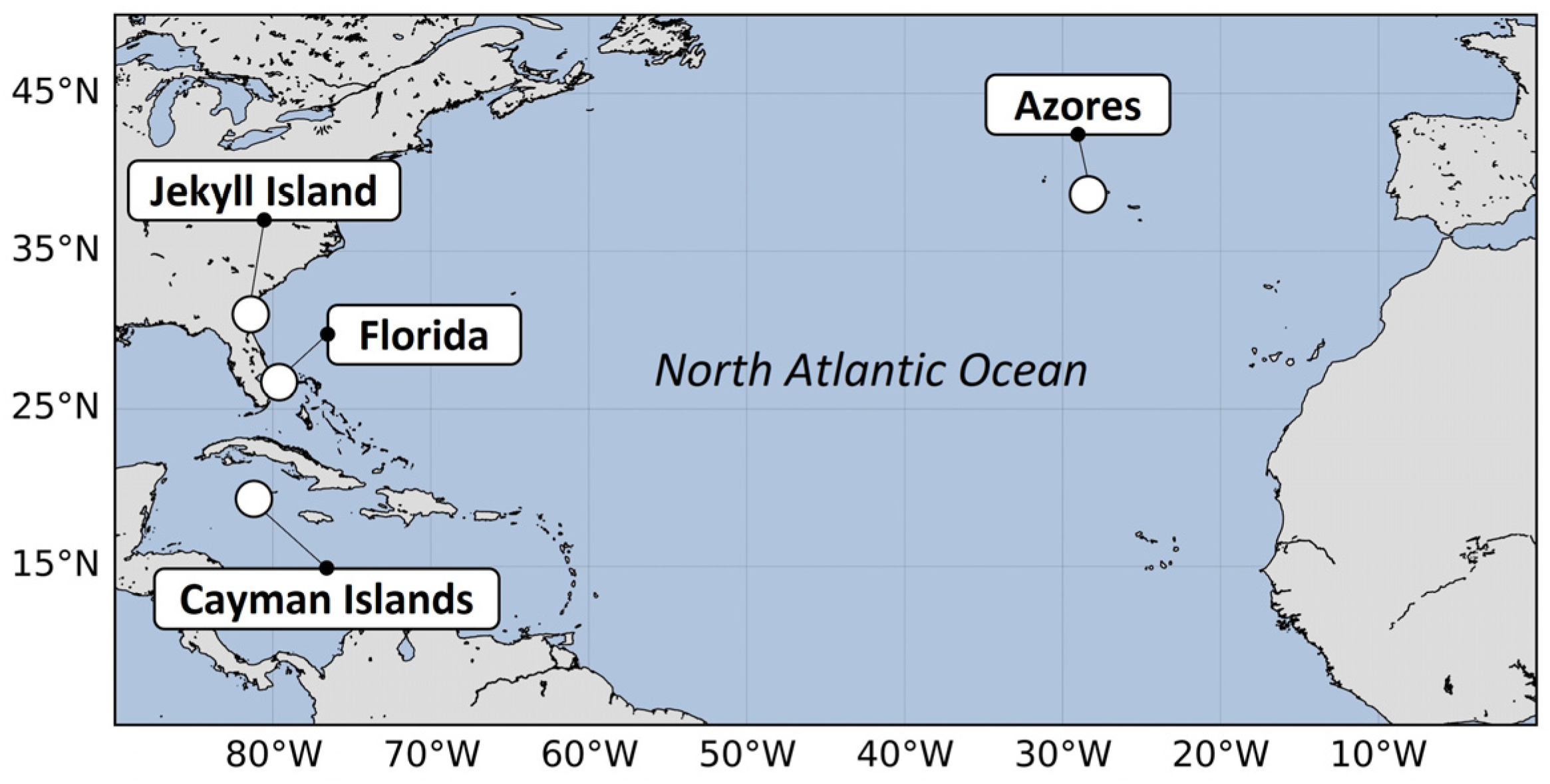
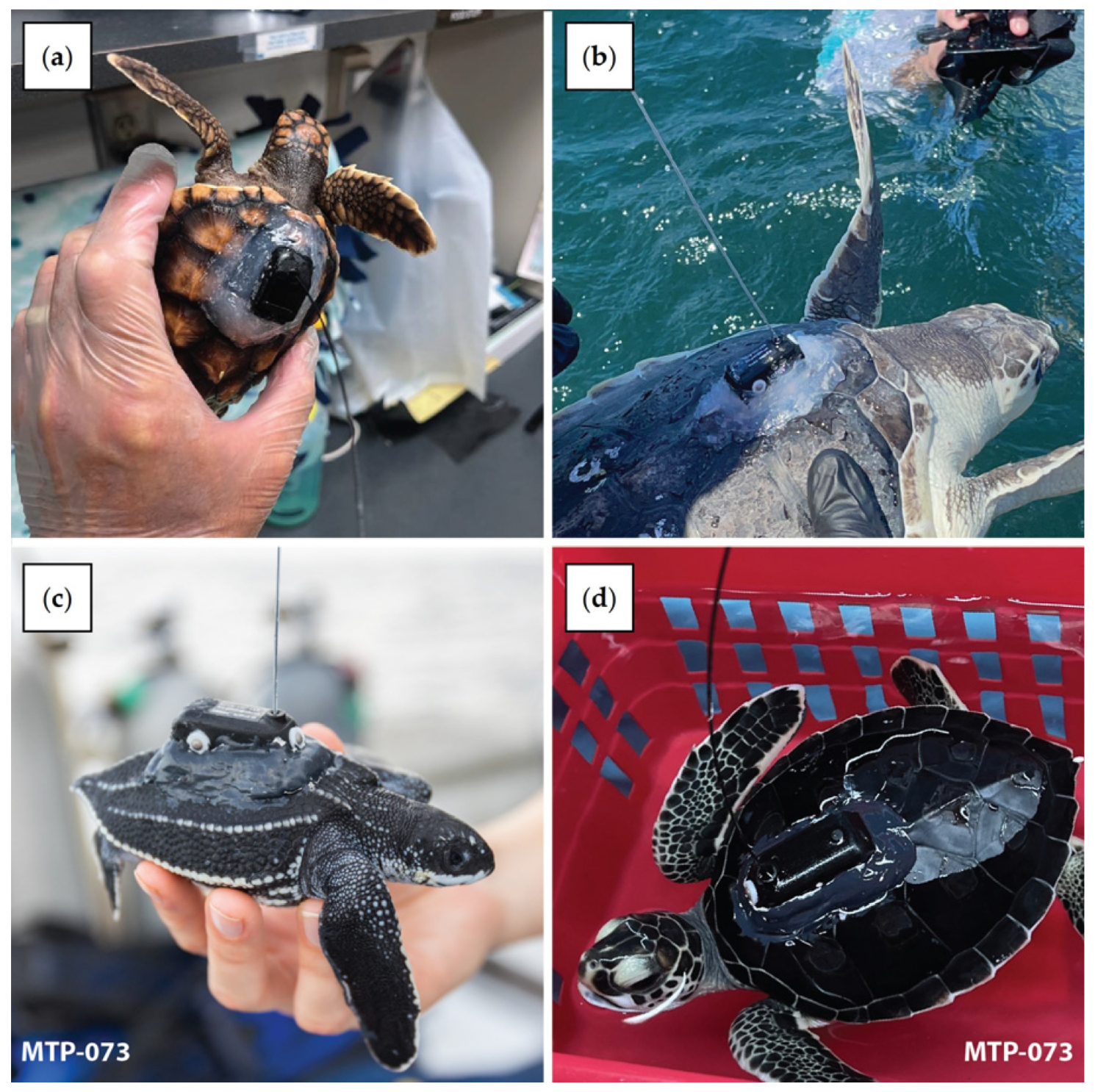
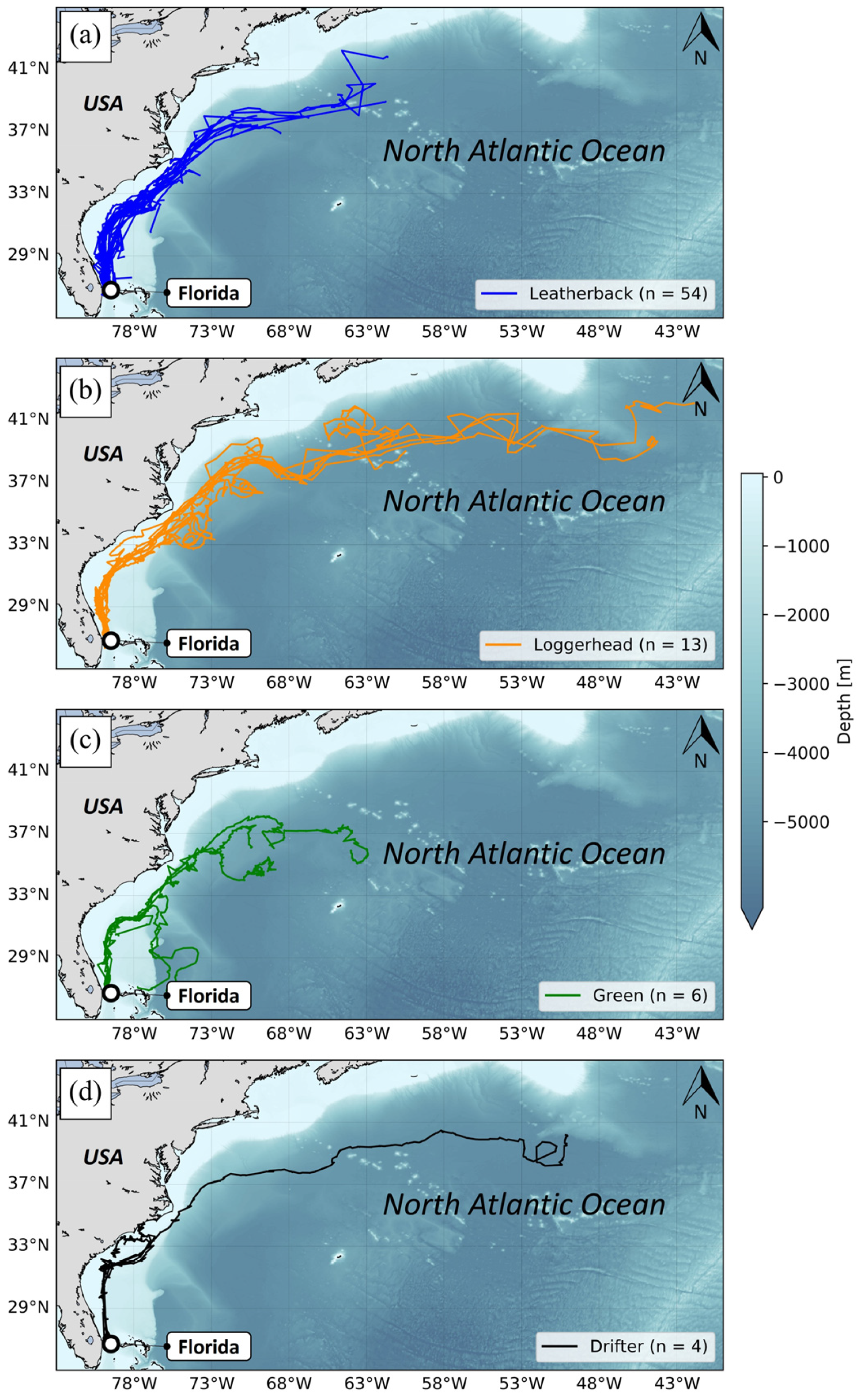
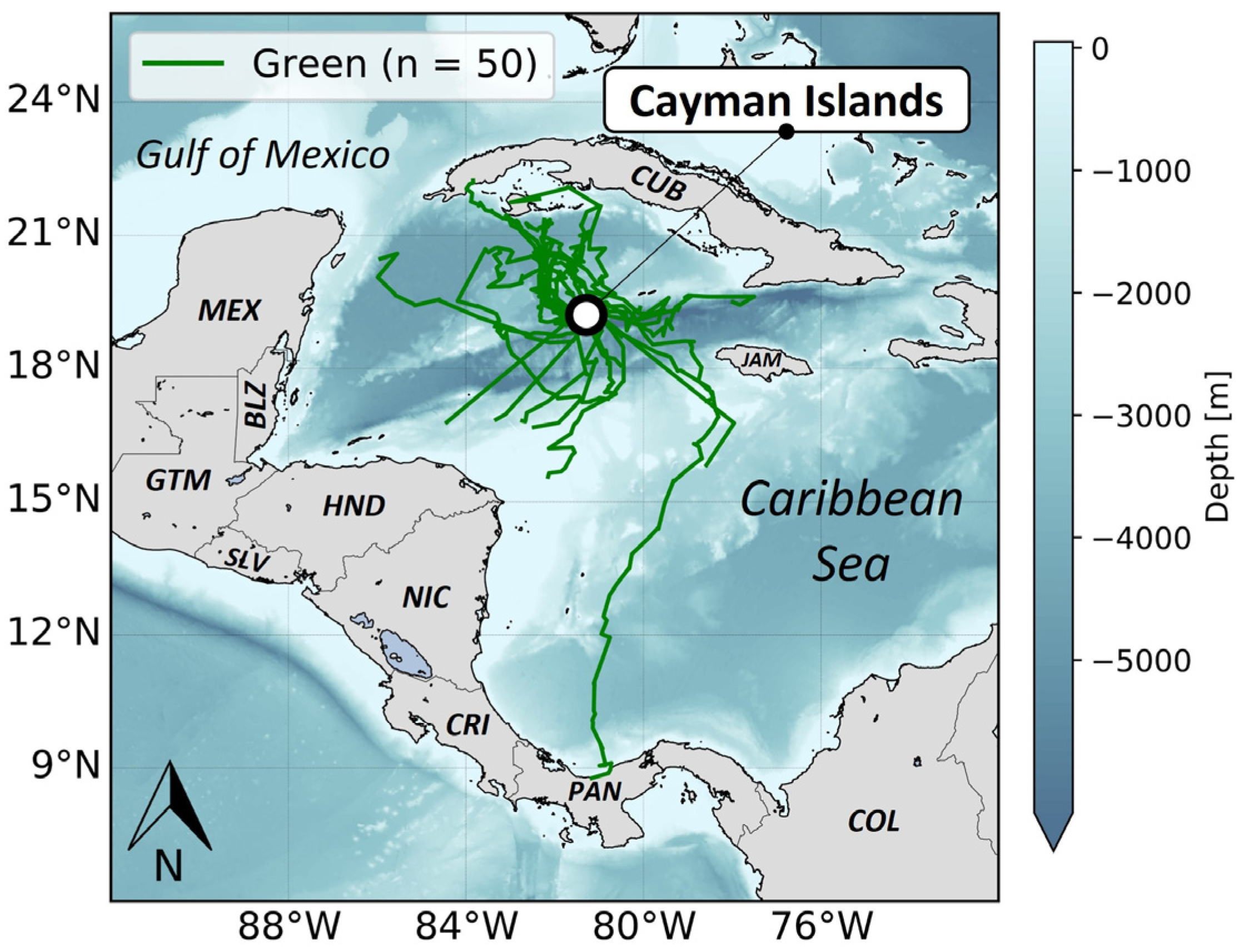
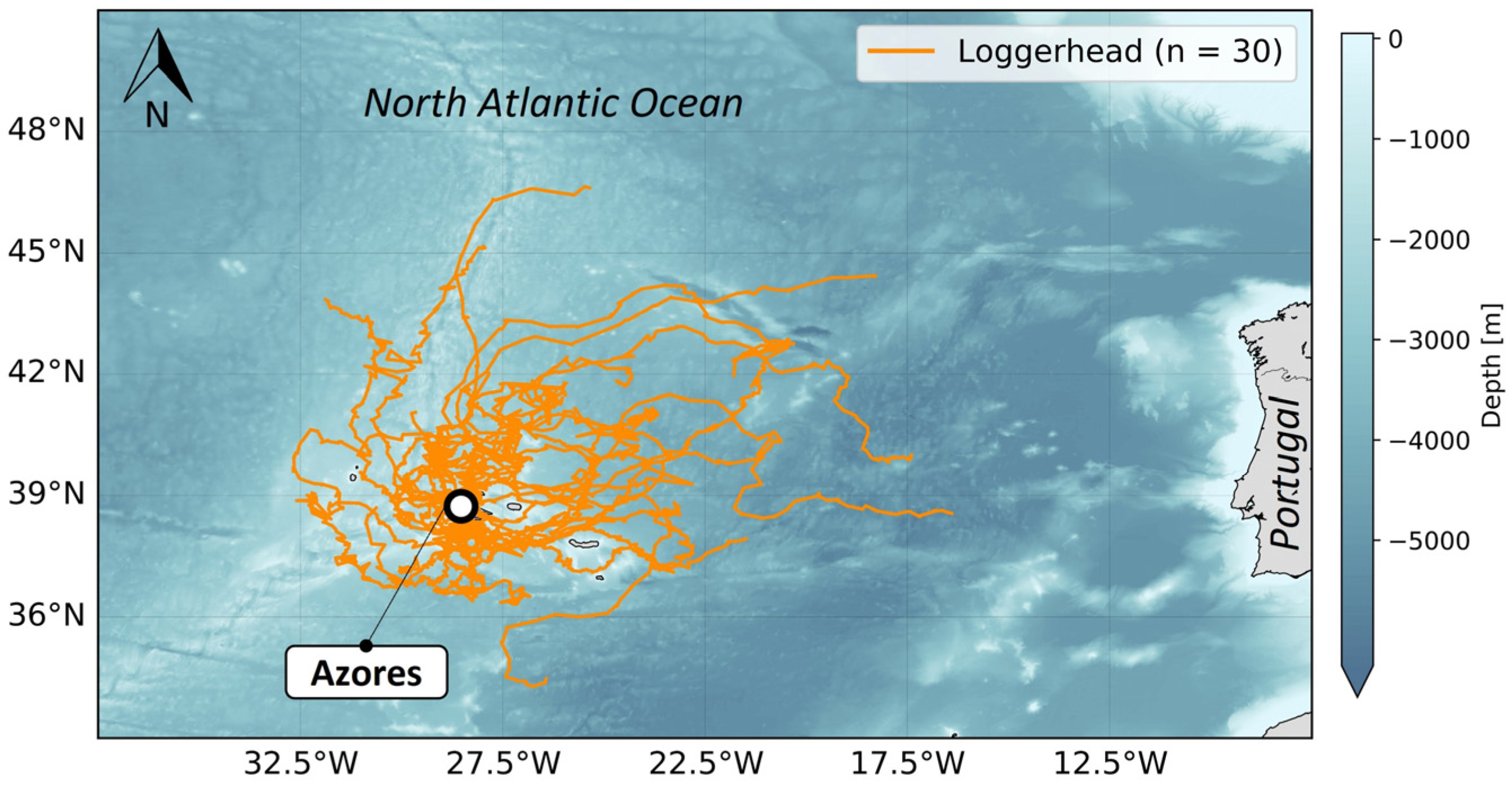
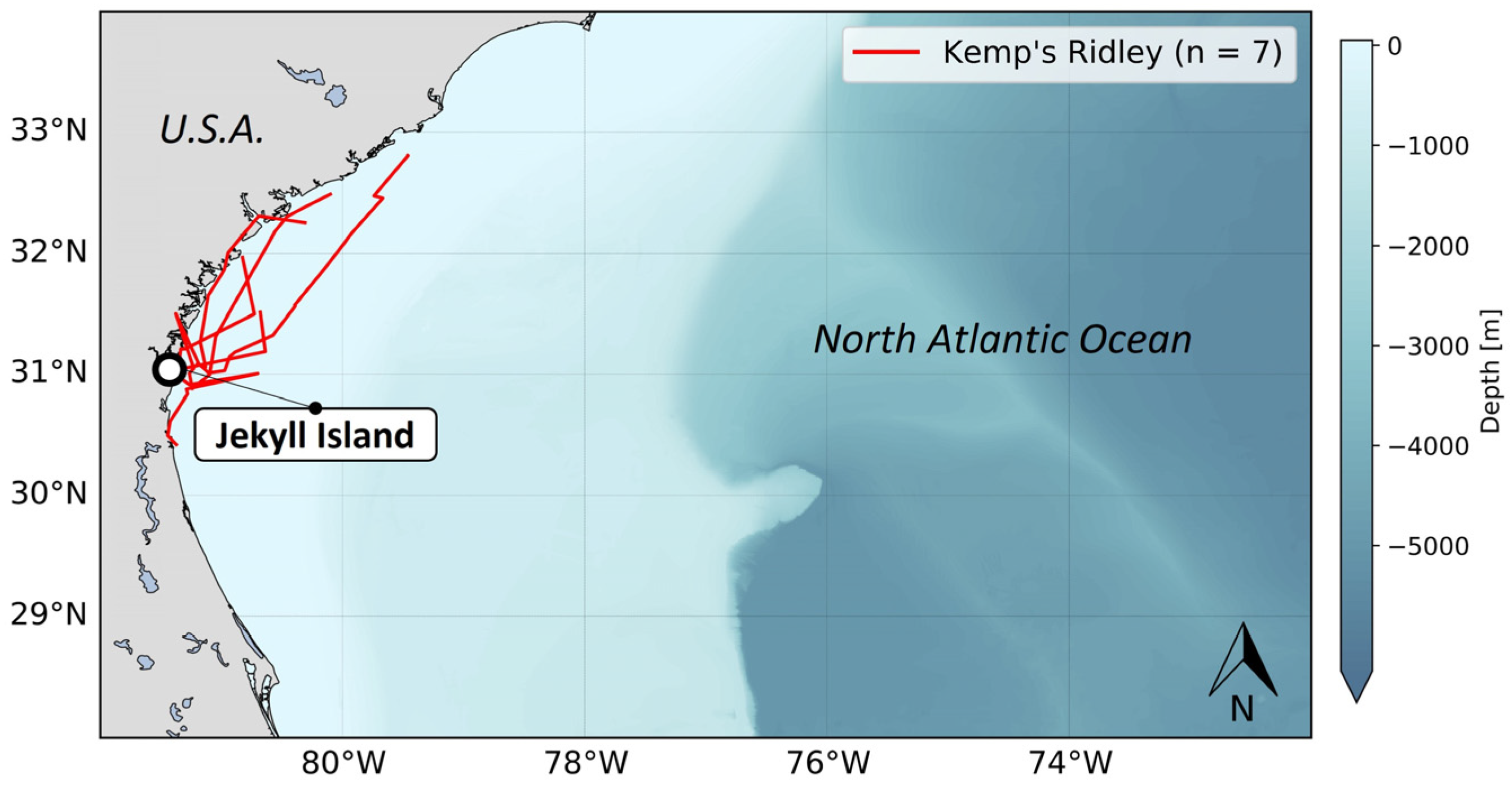
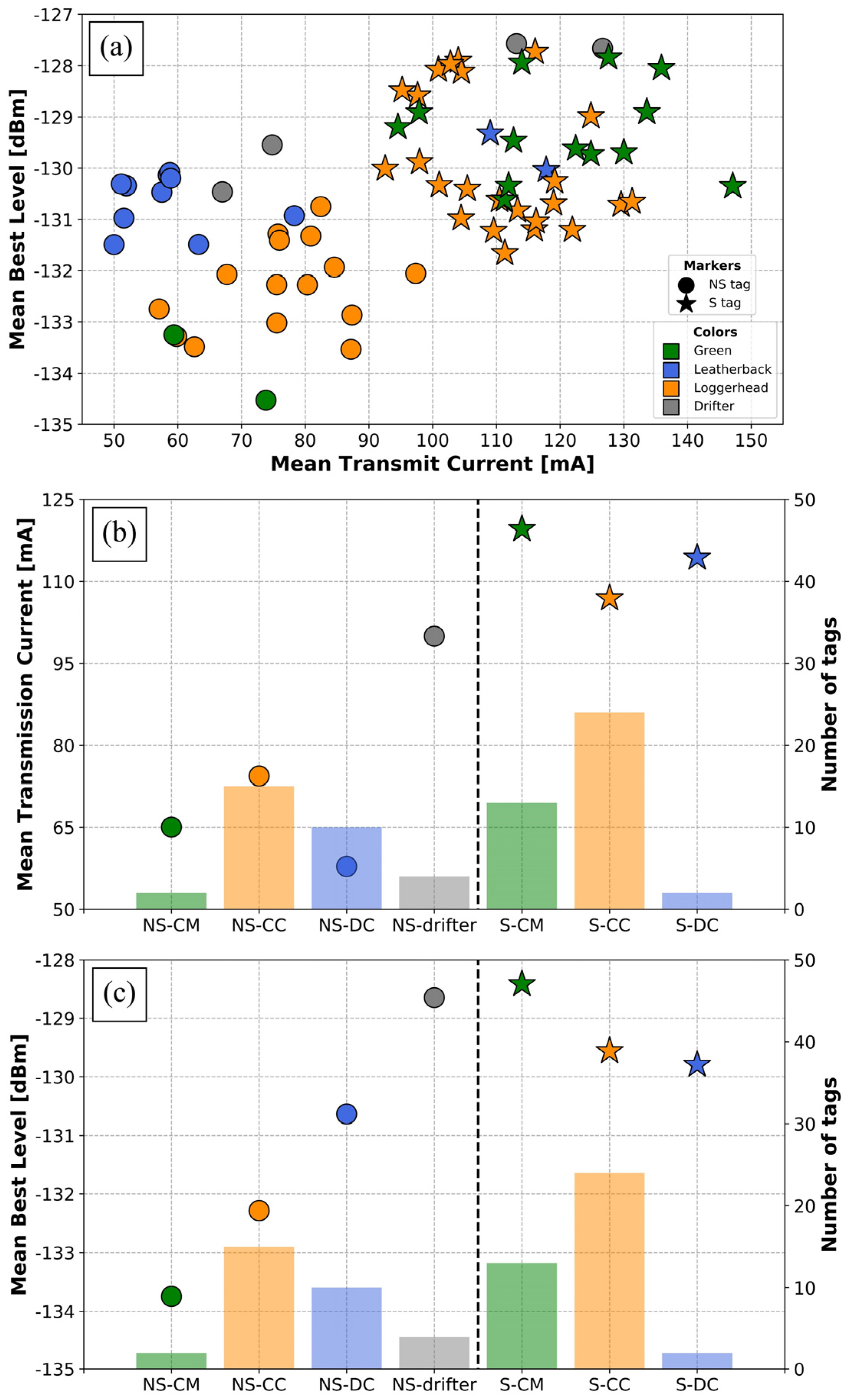
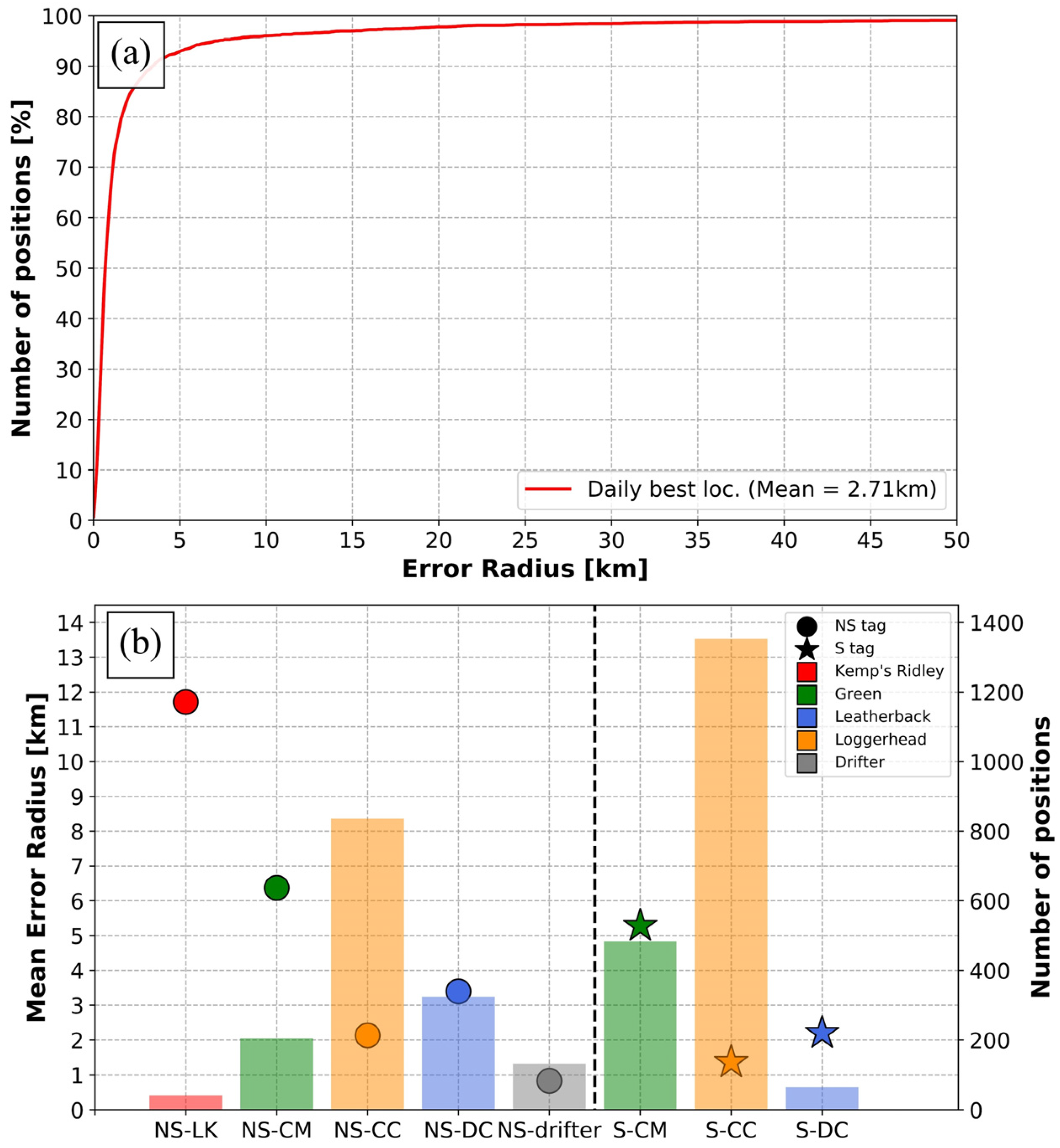

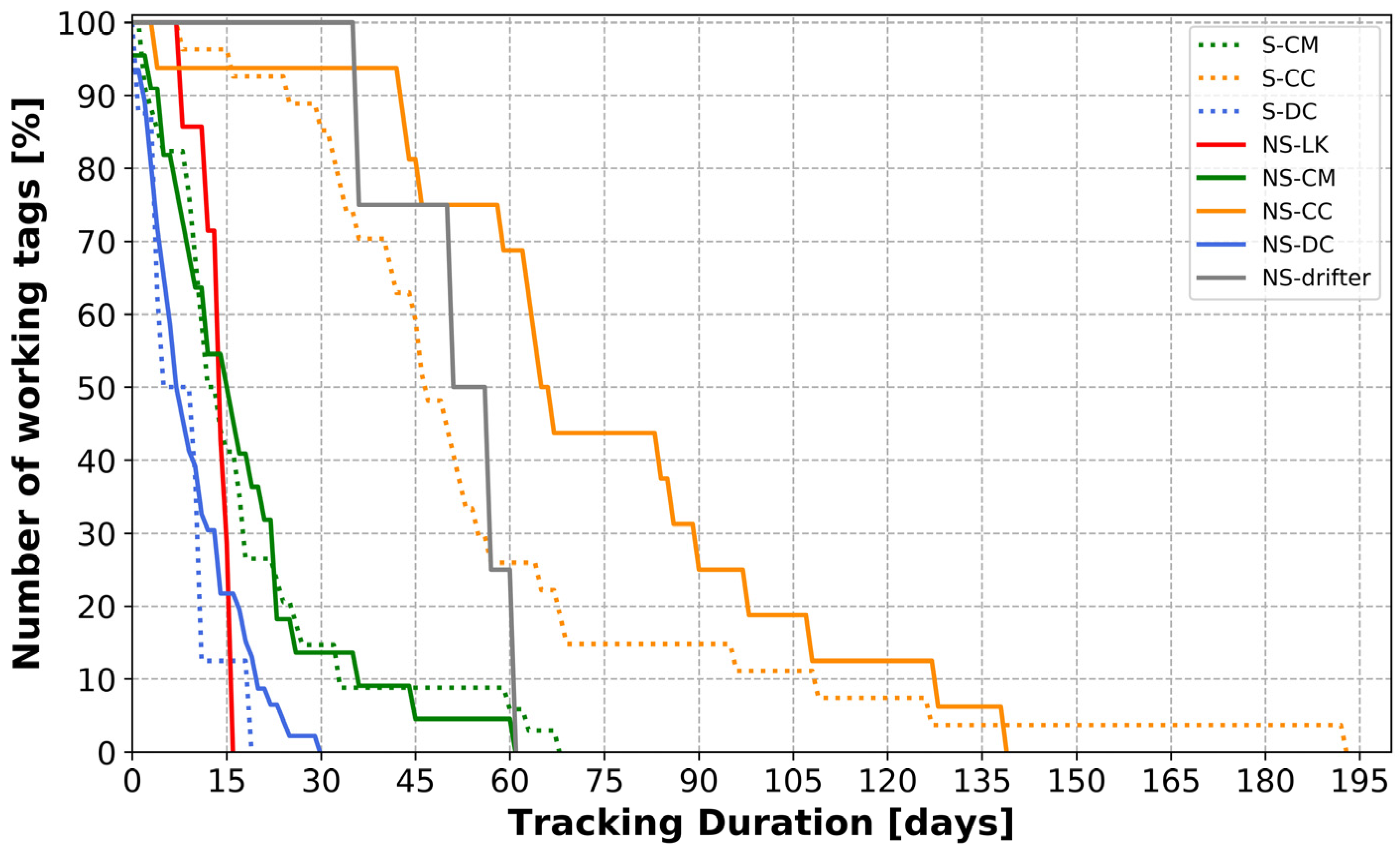
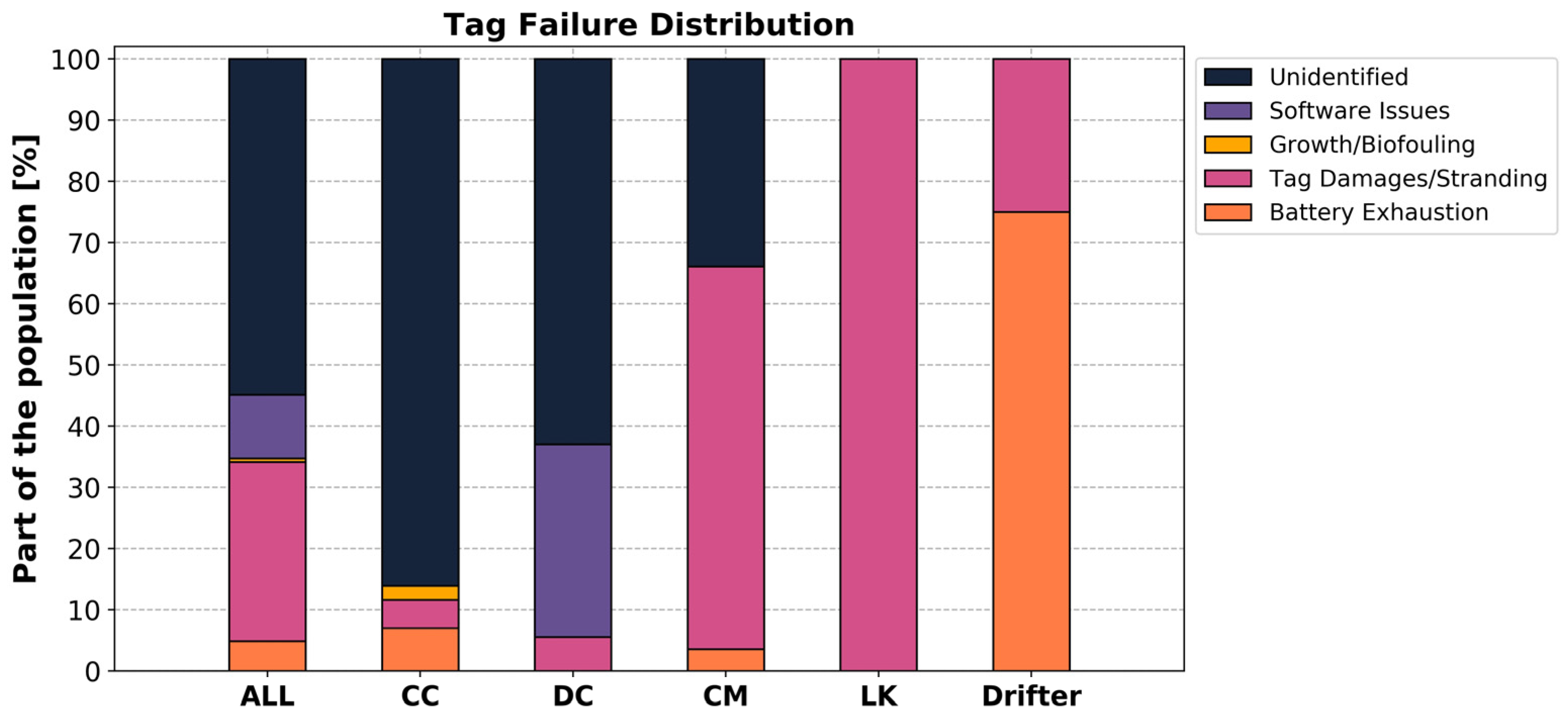
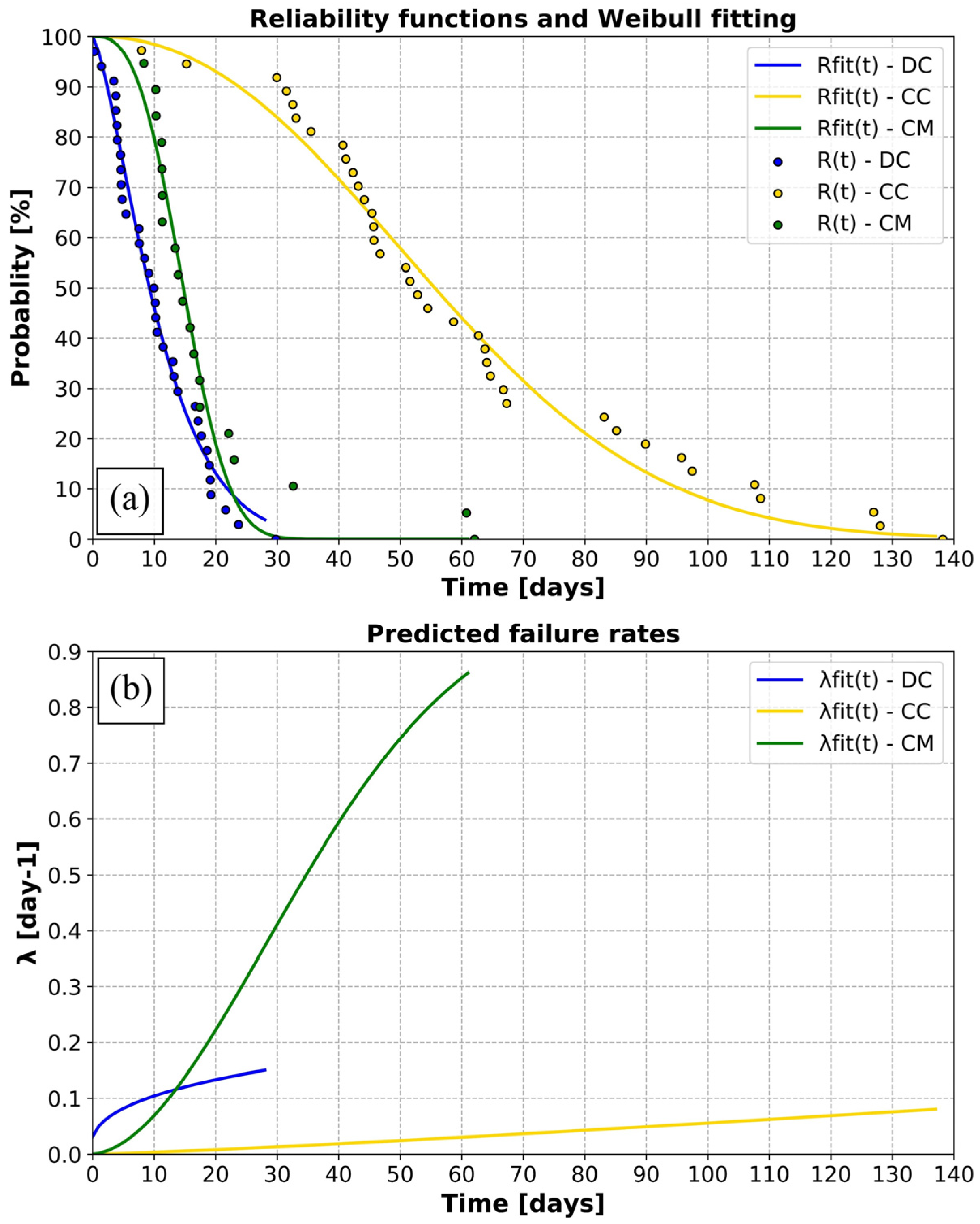
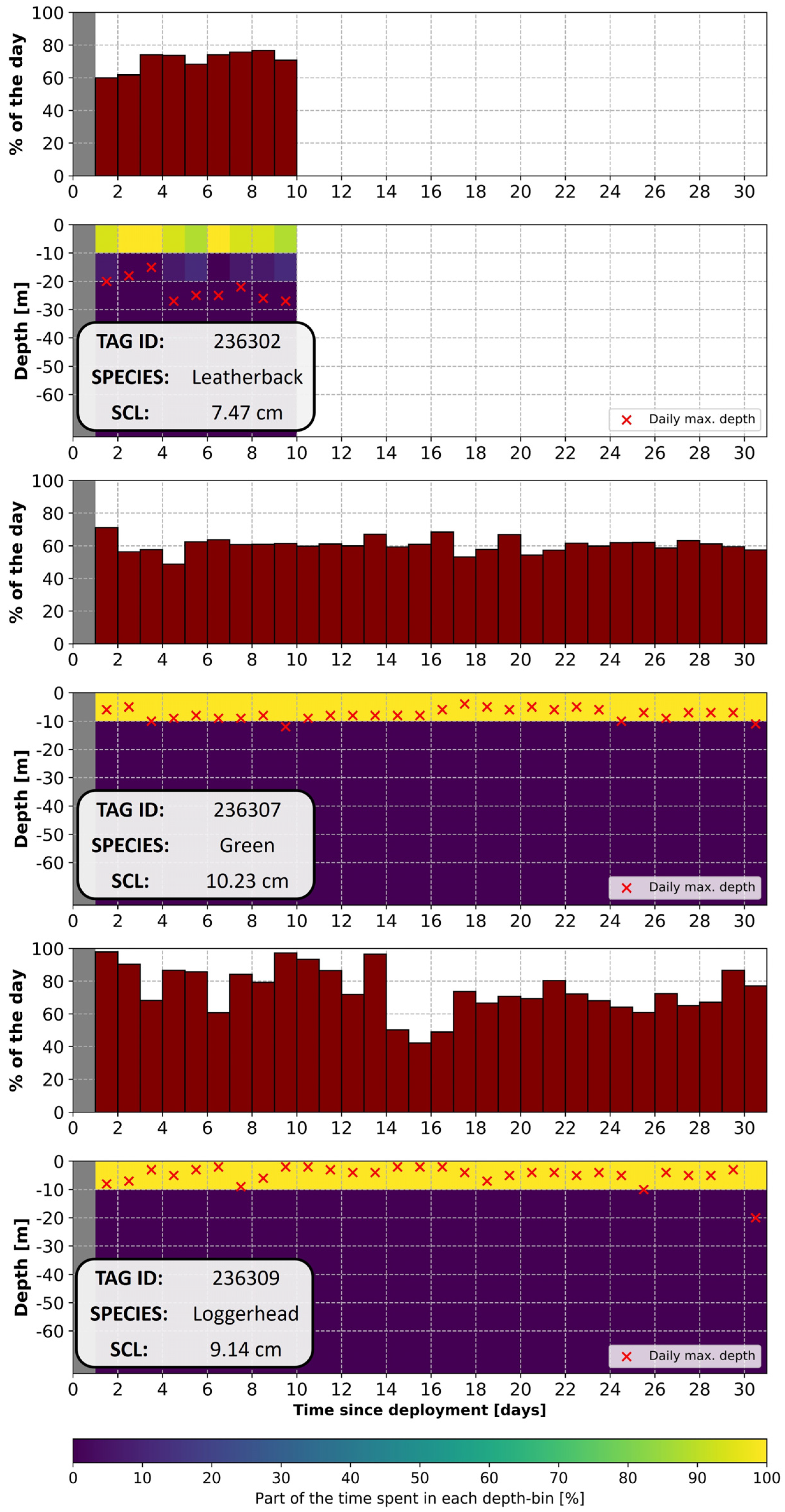
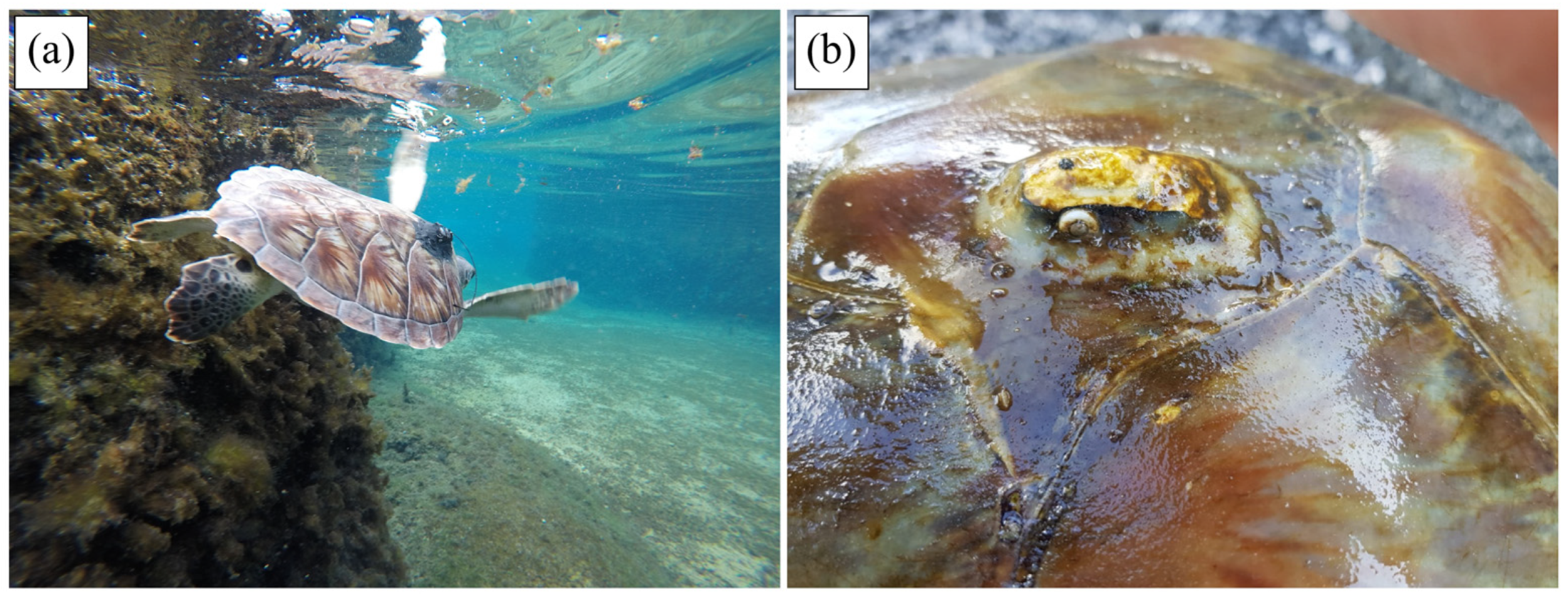
| Species | Straight Carapace Length [cm] | |||
|---|---|---|---|---|
| Mean | Std. | Min. | Max. | |
| Leatherback | 8.78 | 0.59 | 7.14 | 9.65 |
| Loggerhead | 15.57 | 4.38 | 9.14 | 30.90 |
| Green | 32.68 | 11.21 | 9.82 | 51.97 |
| Kemp’s ridley | 27.79 | 2.64 | 24.90 | 32.50 |
Disclaimer/Publisher’s Note: The statements, opinions and data contained in all publications are solely those of the individual author(s) and contributor(s) and not of MDPI and/or the editor(s). MDPI and/or the editor(s) disclaim responsibility for any injury to people or property resulting from any ideas, methods, instructions or products referred to in the content. |
© 2024 by the authors. Licensee MDPI, Basel, Switzerland. This article is an open access article distributed under the terms and conditions of the Creative Commons Attribution (CC BY) license (https://creativecommons.org/licenses/by/4.0/).
Share and Cite
Candela, T.; Wyneken, J.; Leijen, P.; Gaspar, P.; Vandeperre, F.; Norton, T.; Mustin, W.; Temple-Boyer, J.; Turla, E.; Barbour, N.; et al. Novel Microsatellite Tags Hold Promise for Illuminating the Lost Years in Four Sea Turtle Species. Animals 2024, 14, 903. https://doi.org/10.3390/ani14060903
Candela T, Wyneken J, Leijen P, Gaspar P, Vandeperre F, Norton T, Mustin W, Temple-Boyer J, Turla E, Barbour N, et al. Novel Microsatellite Tags Hold Promise for Illuminating the Lost Years in Four Sea Turtle Species. Animals. 2024; 14(6):903. https://doi.org/10.3390/ani14060903
Chicago/Turabian StyleCandela, Tony, Jeanette Wyneken, Peter Leijen, Philippe Gaspar, Frederic Vandeperre, Terry Norton, Walter Mustin, Julien Temple-Boyer, Emily Turla, Nicole Barbour, and et al. 2024. "Novel Microsatellite Tags Hold Promise for Illuminating the Lost Years in Four Sea Turtle Species" Animals 14, no. 6: 903. https://doi.org/10.3390/ani14060903






